Why Belgian vets are saying yes to objective gait analysis
Top Belgian equine veterinarians are clear: Objective gait analysis is becoming as essential as X-rays.
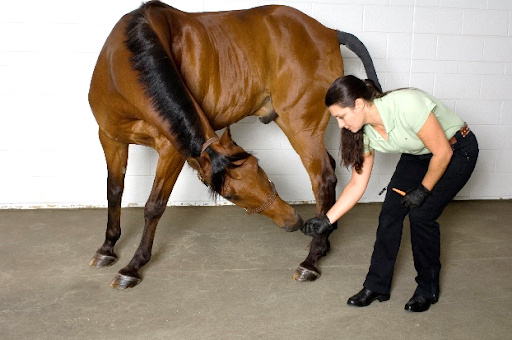
In my previous blog I told you a bit about myself and how I got to where I am today. This time I’ll tell you about some of the areas of research I’ve been involved in. The McPhail Equine Performance Centre was built at Michigan State University to accommodate my research - it represented a new generation of buildings incorporating research and clinical evaluations of sport horses under the same roof. It housed equipment for 3D analysis of kinematics and ground reaction forces as well as a saddle pressure mapping system. Often, though, the tools we needed for research weren’t available commercially and we’d have to cobble together our own equipment. What would we have done without duct tape and baling twine?
Veterinarian, researcher, and horsewoman Dr. Hilary Clayton, BVMS, PhD, Dipl. ACVSMR, FRCVS is a legend. For over 40 years, she’s carried out research in the areas of locomotor biomechanics, lameness, rehabilitation, conditioning programs for equine athletes, and the interaction between rider, tack, and horse. A lifelong rider, she’s also competed in many equestrian sports. We are excited to announce that she will be sharing her expertise through a series of blogs for Sleip.

At Glasgow University I initiated a series of fluoroscopic studies investigating the position and action of various bits in the horse’s mouth. Fluoroscopy provided real-time moving Xray images of the bit inside the horse’s mouth in a way that had never been seen before. About 20 years later these studies were revived and continued in Michigan with the help of Jane Manfredi, a visiting student from the Atlantic Veterinary College. As an aside, Dr. Manfredi was recently appointed as the third MaryAnne McPhail Dressage Chair in Equine Sports Medicine and I look forward to her future contributions to sport horse science.
Getting back to the bit studies, here are some of the things we learned:
One of the areas I was interested in, that required developing our own equipment, was the study of rein tension. The photo below shows the first collection of rein tension data in the McPhail Center. The hierarchy in the lab is evident:
Archival photo of the first collection of rein tension data in the McPhail Center.

Some things I’ve learned about rein tension:
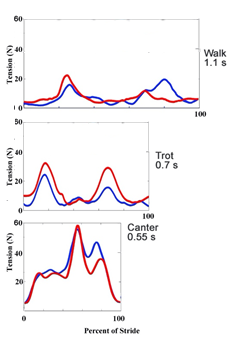
Equestrian sports developed when people realized that the horse’s back could carry a rider. We now know that, although the horse’s back is a convenient place for a rider to sit, there are some potential problems in terms of hollowing the horse’s back and the possibility of high-pressure areas beneath the saddle. The use of a pressure mat provides information about the total force on the horse’s back and how it’s distributed between the left and right sides or the front and back of the saddle. It can also pinpoint focal areas of high pressure that could be uncomfortable for the horse.
Things to know:

Three pressure scans showing the difference in area and magnitude of loading on the horse’s back with a conventional saddle with a tree (left), a treeless saddle (center), and during bareback riding (right). The scans are for the same rider and horse at midstance in sitting trot. The pommel is towards the top right. Note the higher pressures (red and pink areas) for the treeless saddle and bareback riding.
My research team was chosen to collect biomechanical data during the dressage and show jumping competitions at the Olympic Games in Barcelona in 1992 and Atlanta in 1996. It was a great opportunity to analyze data from the best horses in the world at that time.
In the dressage arena, my focus was on the ’3 Ps’ – passage, piaffe and pirouettes. Here are some of the results:
In the show jumping competitions the focus was on how jumping technique and the path of the horse’s Center of Mass (CM) differed between three fence types: a vertical 1.6 m high, an oxer 1.5 m high and 1.8 m wide, and a water jump 4.5 m wide.

Series of photos showing take off, mid-flight and landing of two horses jumping a water jump.
The top horse successfully clears the water, the horse below lands with a foot in the water.
The red lines indicate the horses’ trunk angles. The top horse has a higher trunk angle at take off and, using the horizontal rail for reference, also has a higher trajectory in mid-flight.
One of the skills of managing a research program is recognizing emerging areas that will benefit from evidence-based information. Veterinary physiotherapy is an area in which the McPhail Center was at the forefront of investigating techniques used by equine therapists.

Horse performing a baited stretch. Note muscle activation on the abdominal wall and around the stifle.

Horse trotting with a proprioceptive bracelet (insert) on the left hind pastern.
Note flexion of the hip, stifle and hock.
Hope you enjoyed reading about some of my research. Next time we’ll take a deep dive into ground reaction forces which are an essential component of equine locomotion.
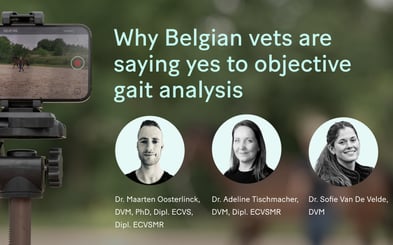
Top Belgian equine veterinarians are clear: Objective gait analysis is becoming as essential as X-rays.
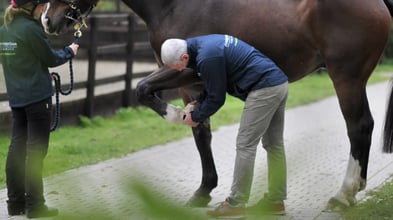
Giorgio Ricardi of Donnington Grove Equine Vets reveals how data-driven gait analysis enhances clinical decisions in complex lameness cases.
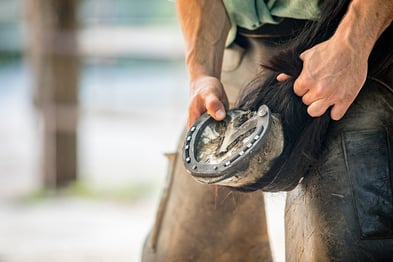
We sat down with UK Master Farrier Marc Jerram, who blends traditional skill with modern gait analysis to spot issues early and collaborate with vets on targeted solutions.